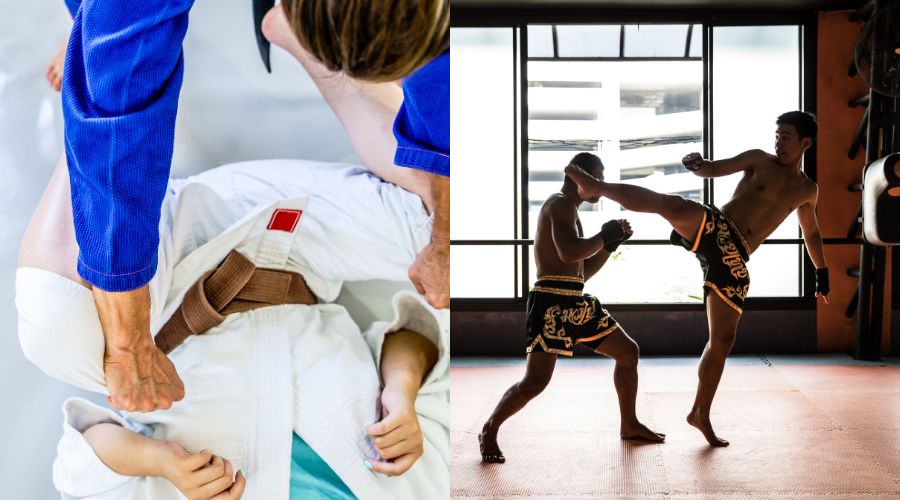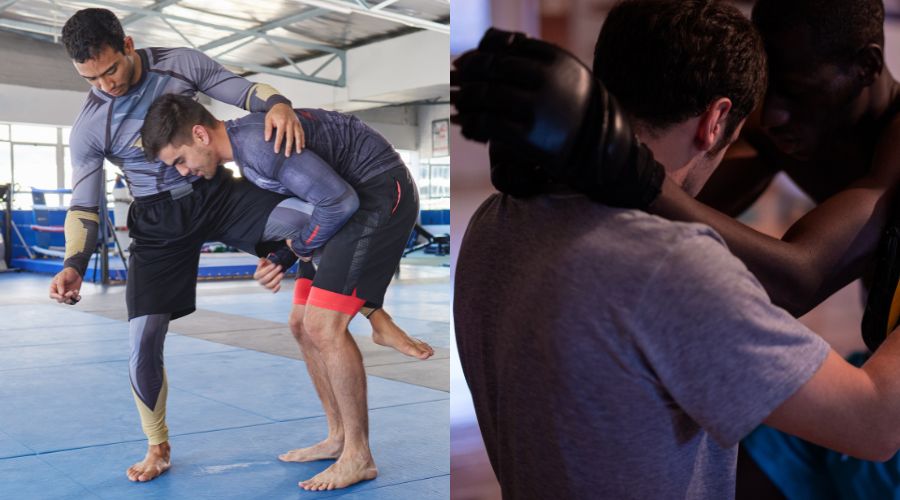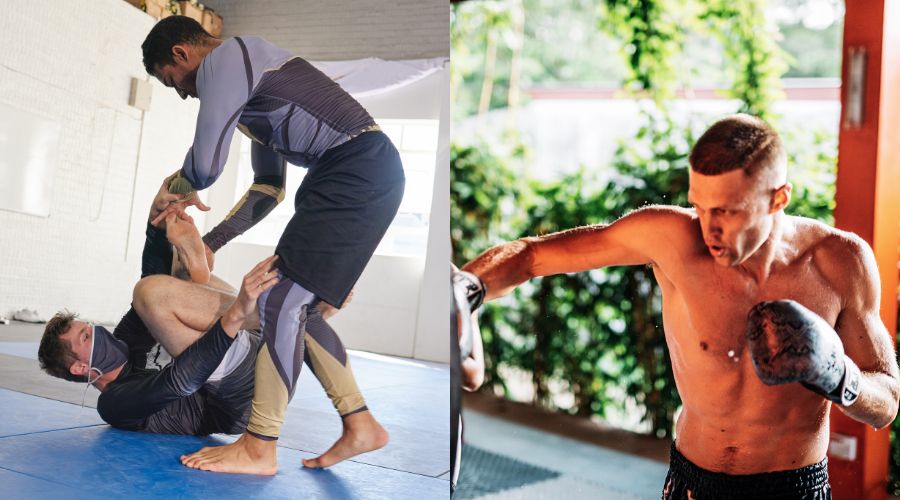Brazilian jiu-jitsu and Muay Thai owe much of their popularity to mixed martial arts. BJJ became the premier grappling style in MMA, while Muay Thai covered the striking aspect, and with the rise of MMA, many people fell in love with the two martial arts separately. But while they are important, do you know what sets them apart individually?
Brazilian jiu-jitsu is a martial art focused on grappling. It relies on a vast arsenal of positions and submissions to ensure dominance once the fight goes to the ground. Muay Thai is a striking discipline known for using elbows, knees, extensive clinching, and punching and kicking.
Having opposite approaches to fighting, BJJ and Muay Thai may have little in common, but they often compete for practitioners, and if you are wondering which one to choose, this guide will provide you with all you need to know.
What Is BJJ
Brazilian Jiu-Jitsu is a grappling martial art focused on submissions. Unlike other grappling martial arts throwing or pinning the opponent is not the primary goal, but submitting him through a joint lock, choke, or another painful submission hold.
BJJ originated in Brazil and was created predominantly by the Gracie family, who took the knowledge of judo, traditional jiu-jitsu, and catch wrestling and molded it into a distinctive combat style.
BJJ evolved through constant challenges against other styles and the philosophy of live training instead of forms and techniques typical for traditional martial arts.
The biggest page for BJJ was opened after Royce Gracie, son of one of the style’s founders, won the first UFC, even defeating much larger men with his ground skills. Since then, BJJ has exploded in popularity and is a well-developed combat sport practiced by millions worldwide.
What Is Muay Thai
Muay Thai or Thai boxing is a striking combat sport originating in Thailand. It is called the art of eight limbs because it allows punches, kicks, elbows, and knees. It is a vicious and highly competitive sport and the pride of Thailand.
The origins of Muay Thai can be found on the battlefields of Siam (the old name of Thailand) and was used for unarmed combat by warriors. Before the modern sporting era, the art was called Muay Boran and was much more brutal.
Still, in the early 20th century, through exposure to Western boxing, Thais adopted the boxing gloves, ring, and judges creating the sport of Muay Thai as we know it today.
Muay Thai is a hugely popular sport worldwide with academies and high-level competitions. Like with BJJ, mixed martial arts is responsible for much of the exposure to the mainstream public, who were introduced to the deadly effectiveness of Muay Thai through cage fighting.
Key Differences Between BJJ And Muay Thai

Rules and Objectives
Key features and rules of BJJ
- BJJ is grappling only with no striking allowed under the sports ruleset
- Self-defense BJJ has some limited striking and striking defense
- Competitions matches are contested on mats
- There are two distinct versions of sport BJJ- gi and no-gi
- A match can be won via submissions or points
- Points are awarded for takedowns, sweeps, guard passing, and holding dominant positions like mount, back mount, side control, and knee on belly.
Key features and rules of Muay Thai
- Muay Thai is striking and clinching, with no ground fighting allowed
- You can punch, kick, knee, and elbow
- Matches are fought in a boxing ring, and fighters must wear boxing gloves
- A match can be won by a knockout, technical knockout, or a judge’s decision
- Judges score the fights according to a few criteria and decide the winner if no knockout is scored
Techniques
Muay Thai is a striking sport that employs all the human body’s limbs. Punches similar to Western boxing are used, but you can also use powerful kicks, elbows, and knees.
Thai-style kicks are the most powerful roundhouse kicks in all martial arts because the mechanics are designed to deliver the most force and damage. This is why Thai roundhouse kicks are landed with the shin, not the foot.
Aside from striking methods, Muay Thai fighters are well-versed in clinching, which is highly regarded in competition. Control, delivering knees and elbows, and tossing or sweeping the opponent out of the clinch are all critical aspects of the game.
BJJ is all about ground fighting and employs many techniques to achieve dominance. The guard position is a crucial element not found in other grappling martial arts.
They are used while you are on your back to limit the offensive options of the person on top and give the person on guard many ways to attack.
Guards are unique because in most other grappling sports being on your back means you lost, while in BJJ, they are a dangerous offensive position.
BJJ is mainly known for the vast array of available submissions, like limb snatching joint locks like the heel hook, Kimura, and armbar. But the most valued submissions are choke holds, which can force the opponent to tap or separate him from his consciousness if he refuses.
Takedowns are also present in BJJ but receive little attention because they do not score highly in competition and cannot lead to a direct victory.
Equipment
BJJ requires only clothing and very few protective items as a grappling martial art.
Equipment for BJJ
- Gi, if you train in traditional BJJ, including a colored belt indicating rank
- Rash guard and no-gi shorts if you train in no-gi. Rash guards are also often worn under the gi.
- Mouth guard
- Other optional protective equipment like knee guards, elbow pads, and groin guards
Equipment for Muay Thai
- Workout clothes, including Muay Thai or other fight shorts and some athletic top
- Boxing gloves
- Shin protectors
- Mouthguard and optional headgear
BJJ vs. Muay Thai For MMA

In the modern landscape of MMA, jiu-jitsu and Muay Thai can be considered equally important for success. Being two of the four main pillars of MMA (the other two are boxing and wrestling), both martial arts cover key elements of MMA.
BJJ takes care of the ground fighting, mainly the submissions. While not everyone needs to be proficient in applying submissions, every MMA fighter must know how to defend against them, so BJJ is a mandatory discipline to train.
Conversely, Muay Thai is the most common striking style used in MMA because It has an extensive knee and elbow arsenal in addition to the punches and kicks common in other martial arts. The art of clinching also plays an essential role in mixed martial arts fights, and Thai boxers excel at close-range fighting.
No MMA fighter can hope to win with only one style, regardless if it’s grappling or striking. This can happen at the lowest stages of the sport, but only there. So the two martial arts we dissect here are crucial for MMA, but none is enough on its own and can’t be called better than the other.
BJJ vs. Muay Thai For Self-Defense

The comparison for self-defense efficiency is also hard to answer directly, aside from saying both are suitable forms of self-defense because of their live training and competitive nature.
While each is better in different situations, BJJ may have a slight upper hand for its ability to handle a situation without causing too much harm.
Here we consider the original version of jiu-jitsu, which was created for self-defense and has no rules for fighting because the modern sports version is less than ideal.
Once you put someone on the ground, if he is untrained, he is helpless. There are countless instances of much smaller people handling aggressors on the ground with swift grappling techniques, which is BJJ’s primary benefit for self-defense.
On the other hand, striking is the fastest way to deal with an attacker, and Muay Thai techniques are fast and wickedly powerful. Striking also conditions you to absorb strikes and not be shocked when a punch lands.
In addition, with Muay Thai, you will learn to judge and control distance much better and read dangerous situations more clearly.
The flaws of each are apparent. BJJ isn’t good against multiple attackers and in scenarios where the opponent manages to stay on his feet. Muay Thai is perfect until you are put on the ground. Both are fantastic self-defense systems, with drawbacks in certain situations.
Who Would Win Between BJJ and Muay Thai?
Muay Thai and BJJ each excel in different planes, so a fight between the two is decided by who succeeds in enforcing his type of fight. Muay Thai wins every time if the fight stays on the feet; if the BJJ guy manages to drag the fight down, he wins easily.
There are plenty of instances of both winning because it depends on the personal skills of the combatants. Additionally, in all cases of cross-style fights in the past two decades, both fighters are well aware of the danger the other possesses and have at least some competencies in the other areas of combat. Here are a couple of stylistic matchups in combat sports.
Should You Start Muay Thai or BJJ?
As we’ve seen, the two martial arts we are comparing today have distinct advantages and disadvantages, and choosing one is a matter of personal preference. To better summarize what both bring, here are the main pros and cons of BJJ and Muay Thai.
Pros of BJJ
- Gentle art– BJJ is a martial art; enduring physical pain and grueling training is part of the deal. But unlike striking martial arts or even wrestling and judo, where throws can be vicious, BJJ is much gentler in its approach.
- Everyone is welcome– BJJ is one of the few martial arts where every age, gender, and physical build can practice and reach relatively high levels. Hobbyists and competitors train side by side, and the whole culture is welcoming.
- Popularity– The level of popularity of jiu-jitsu has exploded over the last couple of decades, and there are countless gyms all over the world, making BJJ one of the most accessible martial arts.
- Endless possibilities– The amount of techniques in BJJ is endless, and there will never be a time when you reach the end of the line and know everything. This makes it a perfect lifelong endeavor.
- Great for self-defense– BJJ will teach you how to handle attackers regardless of their size and allow you to choose the level of violence you want to apply.
Cons of BJJ
- No striking– The most obvious con is the lack of striking, and we know how important it is for a well-rounded fighting skillset.
- Sports BJJ– Most academies focus solely on sports BJJ, where many strategies and tactics are dangerous for self-defense and MMA. The lack of focus on takedowns in sports BJJ further makes it insufficient for real fights.
- It is difficult– BJJ is infamous for its tough progressions system, and the complexity of the martial art makes it hard to master. Early in the journey, BJJ can also be daunting and outright overwhelming with the amount of information and techniques you need to learn.
Pros of Muay Thai
- The art of eight limbs– Muay Thai will teach you to use all your limbs for striking.
- Effective for self-defense– Striking is the quickest way to beat someone, and Muay Thai will give you all the tools to destroy someone in a street fight, including clinching, which is where many real fights end up.
- Easy to get into– Muay Thai has much fewer techniques to work with, and even after a couple of months, you will enjoy it because all drills can be scaled to the level of the practitioner.
- Will make you tough- Muay Thai includes a lot of conditioning which has flaws, but it will make you tough and durable to punishment.
Cons of Muay Thai
- No grappling– Muay Thai limits its grappling to clinch fighting, and if the fight goes on the ground, you will be helpless
- Taxing on the body– Soaking in punishment will make you durable, but it also takes its toll in the long run.
- Training is more repetitive– The fewer techniques and the nature of training are much more repetitive than in BJJ.
Hopefully, this in-depth analysis of the differences between Brazilian jiu-jitsu and Muay Thai has helped you make the right choice or has helped you watch MMA and both sports separately with a more educated mind.
